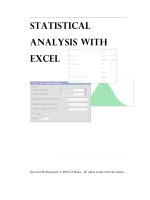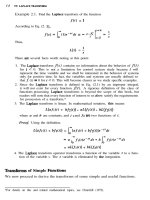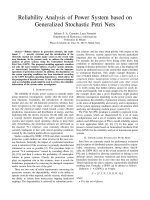Project feasibility analysis
Bạn đang xem bản rút gọn của tài liệu. Xem và tải ngay bản đầy đủ của tài liệu tại đây (150.16 KB, 24 trang )
Materials for Lecture
• Read Chapter 13
• Read three articles on web site
– J. Agribusiness Including Risk in Economic
Feasibility Analysis: The Case of Ethanol
Production in Texas
– IAMA Journal Article on economic feasibility of
Bio-ethanol Production for Wheat in South Africa
– SJAE Use of Probabilistic Cash Flows
•
•
•
•
Lecture
Lecture
Lecture
Lecture
20
20
20
20
Ethanol Feasibility.xls
Project Feasibility.xls
Changing Risk Over Tme.xls
Growth Functions.xls
Project Feasibility Analysis
• Ice Plant article by Richardson and Mapp,
Southern Journal of Agricultural Economics
(SJAE), 1976 – use risk for feasibility analysis
– Demonstrated methodology for risk based
feasibility studies
– Probability of Economic Success
• Probabilistic Cash Flows to meet cash needs
– Recent Feasibility Studies on Class Website
• Including Risk in Economic Feasibility Analysis
• Bio-ethanol Production for Wheat in South Africa
Project Feasibility Analysis
• Most feasibility studies are done using Excel
spreadsheets
– This trend by business started in mid-90s
• Feasibility studies often ignore risk – many do
a “What if …” study for the Best Case and
Worst Case scenarios
• Some analysts think they considered risk by
including a 10 year “average” price
• Excel feasibility models are easily converted
to be stochastic simulation models
– Just make the forecasted variables stochastic
using the residuals from the forecast models
Project Feasibility Analysis
• Risks to consider for a feasibility analysis are:
–
–
–
–
–
Price of raw inputs, as fuel and labor
Price of the product or output
Production risk
Black Swans
Competition and market share over the life of
investment
– Cost of the plant and product development
– Cost of production for the finished product
• Project feasibility is where we put it all
together in an analysis of Time, Money, and
Economic Viability
Project Feasibility Analysis
• Project Feasibility: consider the Time, Money (Cost),
and Economic Viability of the finished business
• Simulate the Time to complete the plant
• Simulate the Cost of developing the plant
incorporating risk into the plant’s development costs
• Simulate the Economic Viability of the completed
plant (business)
P(T)
Project
Management
Time
P(C)
Bid
Analysis
Cost (money)
P( )
Project
Feasibility
Rate of Return
Project Feasibility Analysis
• Proposed business with a new product
• Tasks and duration/costs
Tasks
Description
Time (mo.)
Costs ($1,000)
1
Plant Modification
3-5
300-325
2
Product Development 1-3
200-300
3
Distribution System
2-3
50-100
4
Marketing Program
3-4
100-150
• Finance 100% of project costs @ 9%
• Cost of production/unit Uniform(10,15), can be a scenario variable
• Fixed Costs/year $200,000
• Inflation
Uniform(0.04, 0.05) percent per year
• Demand Projections
Years
Price/Unit
Quantity Sold/Year
1-3
U(13.5,14)
U(500K, 600K)
4-5
U(13,13.5)
U(400K, 500K)
1-3
U(12.5,13)
U(300K, 400K)
Project Feasibility Analysis
• Setting the proposed project up in a Project
Management setting yields the following cost
and time to complete the project
• If these answers are acceptable to
management the next questions is –
– Will the business be economically viable?
Project Feasibility Analysis
• The stochastic final cost of building the plant becomes
input into the project analysis phase of study
Project Feasibility Analysis
• 10 Year analysis gives way to lots of reports
– Annual rate of return to assets
– Things look bad after 6th year
Project Feasibility Analysis
• 10 Year analysis gives way to lots of reports
– Annual net cash income
– Things look bad after 6th year
Project Feasibility Analysis
• Scenario analysis of management control
variables to see if the plant could be more
profitable.
Project Feasibility – Ethanol Plants in Texas
• Ethanol production is dependent on
–
–
–
–
Inputs could be: corn, sorghum, wheat, potatoes, etc
Fuel requirements are: natural gas and electricity
Sale of co-product of DDGS
Sale of ethanol
• Local communities want a plant because it hires 35
to 50 people year around, farmers have dependable
market for grain, and given a $2.25/gallon
construction cost it generate jobs (at least for 6-9
months)
Project Feasibility – Ethanol Plants in Texas
• Develop a Feasibility Model for an
Ethanol plant in Texas
• Location: High Plains due to feedlots
and local corn/sorghum supplies
• Rail transportation facilities available to
import corn and ship ethanol
• KOVs
–
–
–
–
Net Present Value
Annual cash flows
Probability of cash flow deficits
Probability investors get their money back or the
P(Increase Real Net Worth)
Project Feasibility – Ethanol Plants in Texas
• Stochastic variables
–
–
–
–
Corn and sorghum prices
DDGS price
Ethanol price
Electricity and natural gas prices
• Develop MVE distribution for these prices based on
prices for the past 10 years
• Problem with stochastic prices
– Must use Texas prices and we have forecasts for National
prices
Texas Price = a + b National Price + e
Simulate a stochastic national price and use in Texas price
Project Feasibility – Ethanol Plants in Texas
• Develop a Financial Simulation Model :
Income Statement, Cash Flow, and Balance
Sheet
• Simulate 10 years using corn as the feed
stock
• Assume a learning curve for management to
bring the plant up to its full capacity
• Validation exercises
–
–
–
–
4 Ps
Touring test with other economists
Presented results to local investors
Presented results to politicians
Learning Curve or Demand Cycle
• A new business may need a few
months or years to grow sales to their
potential
• It may take months or years to learn
how to reach potential of prod function
• In either case, assume a stochastic
growth function and simulate it, if
nothing else is available, use a Uniform
distribution
• Example of a growth function for 8
years
Learning Curve or Demand Cycle
Life Cycle Costing
• A new concept in project feasibility
analysis
• Explicitly consider externalities
– Such as cleanup costs at end of business
• Buried gas tanks
• Disposal of dirt with oil and gasoline spills
• Disposal of old parts and tires/batteries
• Renovation of land after a strip mine
• Cleanup after oil well is drilled
• Oil spills (ship wreck, train wreck w/ haz chem)
Changing Uncertainty Over Time
• We may want to change the uncertainty
for a random variable as time
progresses
• This is done by adding an Expansion
factor (Et)to the stochastic variable
• For an Empirical Distribution
Ỹ= Ŷ *(1+EMP(.) * Et)
where Et is a fraction from 0 to infinity
Et = 1 causes risk to equal historical risk
Et = 2 doubles historical risk
Changing Uncertainty Over Time
Changing Uncertainty Over Time
• For a Normal Distribution the process is
slightly more complicated
Ỹt = NORM(Ŷt , σ * Jt * Et)
where Jt normalizes the standard
deviation for changes in the mean
– Jt = (Ŷt / Historical Ŷ)
– Et is a fraction from 0 to infinity
Et = 1 causes risk to equal historical risk
Et = 2 doubles historical risk
Changing Uncertainty Over Time
Life Cycle Costing
• Steps to Life Cycle Costing Analysis
– Identify the potential externalities
– Determine costs of these externalities
– Assign probabilities to the chance of
experiencing each potential cost
• Assume distributions with GRKS or Bernoulli
– Simulate costs given the probabilities
– Incorporate costs of cleanup and
prevention in the project
Life Cycle Costing
• Bottom line is that LCC will increase the costs
of a project and reduce its feasibility
• Affects the downside risk
• Does nothing to increase the positive returns
• Need to consider the FULL costs of a
proposed project to make the correct decision
• J. Emblemsvag – Life Cycle-Costing: Using Activity-Based
Costing and Monte Carlo Simulation to manage Future Costs
and Risks John Wiley & Sons Inc. 2003









